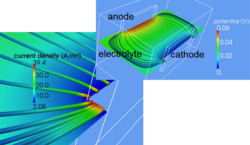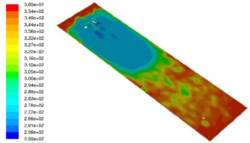Computational Fluid Dynamics (CFD)
MCL is engaged in the highly elaborate field of CFD-simulations with focus on process-simulation. The research areas cover:
- Turbulent flow,
- Chemical, thermal and electrolytic processes (multi-physics),
- Multi-phase flow (e.g. particle-laden flow, film flow and film wiping, spray, free surface flow),
- Simulation of multi-species transport problems on micro-structural levels.
Commercially available software (Fluent®), as well as OpenSource packages like OpenFOAM® are employed. This offers the opportunity to solve industrial problems and to develop and implement customer-specific models.
Turbulent flow in a thermo-chemical process
The problems and demands in process-simulation are far beyond a simple description of the flow- and temperature field. More often than not, the mass-transport, thermodynamics and reaction kinetics have to be taken into consideration, as demonstrated in the process of hot-dip galvanizing [Mataln2015].
In other fields, additional physical phenomena occur, which have to be modelled, like the electro-deposition process. In this case, not only the flow-field and the mass-diffusion of the species, but also the effects of the electric field and migration of ions have to be calculated.
Multi-phase simulation
The accurate simulation and description of multi-phase flows plays an important role in process simulation in order to enhance quality, efficiency and security of production processes. Depending on the inherent process characteristics, different phases (gaseous, fluid, solid) co-exist. Physical and chemical processes like mixing, solubility, heat- and mass-transfer can occur, and have to be modelled adequately.
An example of a successful application of multi-phase simulation is the optimization of high-speed wiping nozzles in the continuous hot-dip galvanizing process. The height of the liquid zinc coating is reduced employing a transonic gas-jet. In order to predict the height, a detailed modelling with LES-VOF technique is required, which includes the interaction between the high-speed gas flow and the liquid zinc film. A detailed knowledge of this interaction offers the opportunity to optimize process parameters with respect to uniform coating thickness [Pfeiler2014,Pfeiler2015].
Another application example of multi-phase modelling are spray-processes, like cooling of components or spraying of etching or coating chemicals. The correct modelling of the surface interactions (e.g. wetting of a surface, phase-changes, heat-transfer, chemical reactions …) is of the utmost importance to get reliable results.
Simulation in micro-structures
Current state-of-the-art X-ray computed tomography (CT) scans are capable of measuring detailed porous micro-structures. The data can be reconstructed into a computational grid, using adequate segmentation algorithms. This offers the opportunity to simulate physical phenomena on the micro-meter scale and to foster the understanding of the underlying process.
An example is the computation of the gas-diffusion through the porous metallic support of a metal-supported solid oxide fuel cell (SOFC). The effective mass-transport of hydrogen could be determined in the measured porous substrate [Reiss2015a]. In addition to that, a corrosion model is implemented which is capable of determining the growth of an oxide layer during operation (see Figure 5). The decreased pore size hinders the gas-diffusion and reduces the efficiency of the SOFC. With this knowledge a prediction of the mass-transfer related losses due to corrosion could be determined [Reiss2015b].
Publications
Turbulent flow in a thermo-chemical process
- M. Mataln, C. Pfeiler, J. Strutzenberger et al., Simulation of Physical Phenomena inside a Molten Zinc Bath by using Computational Fluid Dynamic Methods, in: Conf. Proceedings of the 10th International Conference on Zinc and Zinc Alloy Coated Steel Sheet, GALVATECH 2015, Toronto, Canada, (2015) 481-488
Multi-Phase-Simulation
- C. Pfeiler, M. Mataln, A. Kharicha et al., Importance of the Zinc Film Modeling for Gas Jet Wiping Simulations, in: Conf. Proceedings of the 10th International Conference on Zinc and Zinc Alloy Coated Steel Sheet, GALVATECH 2015, Toronto, Canada, (2015) 682-689
- C. Pfeiler, M. Mataln, A. Kharicha et al., Simulation of Zinc Formation during Continuous Withdrawal of Steel Strips from Galvanizing Baths, in: Conf. Proceedings on International Conference on Metallurgy and Materials 23 (2014)
Simulation in Micro-Structures
- Reiss, Georg; Frandsen, Henrik L.; Brandstätter, Wilhelm; Weber, André: Numerical evaluation of micro-structural parameters of porous supports in metal-supported solid oxide fuel cells. In: Journal of Power Sources 273 (2015a), pp. 1006-1015.
- Reiss, Georg; Frandsen, Henrik L.; Weiß, Christian; Brandstätter, Wilhelm: Simulation of oxide growth in metal-supported solid oxide fuel cells and its influence on micro-structural mass transport. In: Journal of Power Sources 297 (2015b), pp. 338-399



















![Temperature distribution in the symmetry plane of a zinc pot. The path-lines show the velocity field of the inductors, which maintain a desired bath temperature [Mataln2015].](/fileadmin/_processed_/9/6/csm_Simul_FE_Stroemungsmech_12da03cbc7.png)

![High-speed wiping nozzle in action. The controlled gas-jet yields an optimized coating [Pfeiler2015].](/fileadmin/_processed_/6/b/csm_Simul_FE_Stroemungsmech2_0b686afcf5.png)

![Pores of the micro-structure (left), the oxide layer (middle), and the transient change of the mean porosity for different operating temperatures [Reiss2015b].](/fileadmin/_processed_/4/5/csm_Simul_FE_Stroemungsmech3_5e87683327.png)